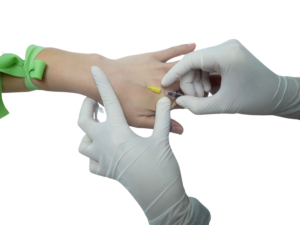Disaster Triage, Prioritizing, and Delegation
4 Topics | 2 Quizzes
Neurological System
10 Topics | 1 Quiz
MS, MG, and Guillain Barré
4 Topics | 1 Quiz
The Cardiovascular System
12 Topics | 1 Quiz
Pulmonary System
10 Topics | 1 Quiz
Cushing Versus Addison Disease
3 Topics | 1 Quiz
Thyroid Disorders
2 Topics | 1 Quiz
Parathyroid Disorders
3 Topics | 1 Quiz
DI and SIADH
3 Topics | 1 Quiz
Diabetes
10 Topics | 1 Quiz
Burns
5 Topics | 1 Quiz
Anemias, Aplastic Anemia, Polycythemia Vera, Thrombocytopenia and DIC
9 Topics | 1 Quiz
Cancer, Chemotherapy, Radiation Therapy, and Oncological Emergencies
6 Topics | 1 Quiz
Leukemias, Hodgkin’s Disease, and Multiple Myeloma
4 Topics | 1 Quiz
The GI system
16 Topics | 1 Quiz
Renal and Genitourinary Problems
6 Topics | 1 Quiz
Infection and Isolation Precautions
3 Topics | 1 Quiz
NCLEX Pharmacology
3 Topics | 1 Quiz
TPN, IV Solutions, & Blood Products
6 Topics | 1 Quiz
Lab Values
9 Topics
IVs and Central Lines
IV Gauges

- The smaller the gauge the larger the diameter. For example, 18G is larger than 24 G.
- Large diameter or small gauges for high concentration and faster rates.
- Smaller diameter or larger gauges for slower rates and low concentration fluid.
- 14-19 Gauge: Rapid emergency fluid administration, blood products, and anesthetics
- Some sources says that 20G is ok for blood products. But 18G is better to prevent hemolysis.
- 20- 21 Gauge: Peripheral fat emulsion (lipids).
- 22-25 gauge: Standard IV fluids

- IV insertions: No IV on same side as AV fistulas/ shunts, infected skin, same side as mastectomy, weak or swollen extremity.
- Insert IV on the non-dominant side. If a client is right-handed, use the left arm. If a client is left-handed, use the right arm.
- Hand/arms are suitable IV sites, but for adults legs are not suitable sites due to thrombus formation.
- Place tourniquet 3-4 inches above the insertion site and clean site per protocol before inserting IV.
- Check for latex allergies.
- Trivia: Who has a high possibility of latex allegic? Spina Bifida clients. Know this!
IV Complications
| Complications | Signs and Symptoms | Nursing Action | Preventive Measures |
|---|---|---|---|
| Infiltration | Swelling Pale and cool skin around the IV site slow infusion | Stop and remove IV Elevate arm to decrease swelling Warm compresses Start new IV at a different site | Select a large vein Make sure IV flushes well before starting infusion |
| Phlebitis | Swelling at the site Burning/pain at the site Redness at the site | Stop Infusion Elevate arm Warm compresses Start new IV at a different site | Use Aseptic technique when starting IV Good handwashing Change IV every 72 hours |
| Cellulitis | Swelling at the site Burning/pain at the site Redness at the site Fever and Chills Note: more Systemic than phlebitis | Stop Infusion Elevate arm Warm compresses Start new IV at a different site | Use Aseptic technique when starting IV Good handwashing Change IV every 72 hours |
| Bruising or Hematoma | Bruising with the buiding- up of blood after IV is removed that leads to a hematoma | Apply pressure after IV is removed Cold Compresses | Apply pressure after catheter is removed until no more bleeding |
Preventing Central-Line Associated Bloodstream Infections (CLABSIs)

Hand Hygiene per protocol

Assess site every shift

Clean site with Chlorhexidine in circular motion. Not alcohol. Betadine ok if allergic to Chlorhexidine.

Scrub the hub with alcohol when giving meds or changing IV tubing.

Change transparent dressings every 5 to 7 days. Regular dressings every 2 to 3 days.

Avoid unnecessary disconnections of IV tubing. Remove central lines not being used.
